American Beehives
Reprinted from "Crown Jewels of the Wire", March 2005, page 26
Samuel Oakman, the inventor and glassmaker behind Boston Bottle Works
insulators (see June 2004 issue of Crown Jewels) in the 1870's, had moved to New
York by the mid-1880's. He still owned a glass factory in Boston, and some
collectors believe some base embossed American Insulator Company products, such
as the CD 134 Americans that lack a reference in the embossing to New York, may
have been made there.
This month, Crown Jewels features the beehives made by the American Insulator
Company. The insulators pictured in this article are from the collection of Jack
Roach, and were photographed from his display at the 2004 Western Regional
Insulator Show in Denver, Colorado.
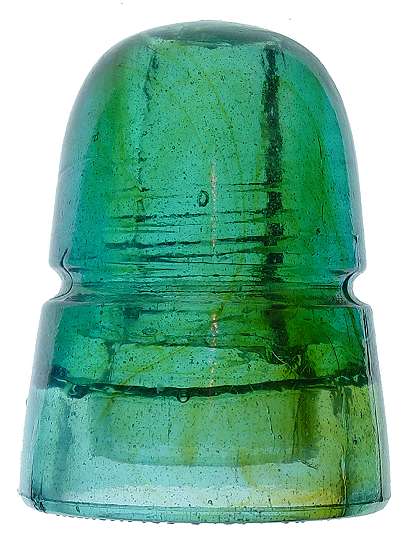
As you will see in this eight page article, there are some outstanding
insulators in various shades of green. But don't for a minute think that green
is a common color. These are some of the best and brightest colors known in the
family of American brand insulators. From the two-tone example (above on
this page), to the dramatically different shades of green seen through the
article, these are truly American beauties. A total of 20 different American
beehives are pictured here.

History
Samuel Oakman is named in the City Directory for New York in 1885 & 1886.
At the same time, the Boston directory listed an American Insulator Company.
This fact lends to speculation that American insulators which fail to mention
New York in the embossing might have been made in Boston.
If so, production of insulators embossed with the American Insulator Company
name could have begun around 1883 to coincide with Oakman November 12, 1883
patent for an inner skirt. American embossed insulators also contain other
patent dates, which are discussed later in this article.
By 1890, Samuel Oakman's name can again be found in the Boston city
directory. He operated business under the names Oakman Manufacturing Company
and Oakman Glass works between the years 1890 and 1897.
Commercial distribution of electrical power was coming into its own during
this period and Oakman received various patents for power insulators. Included
were patents for cable grooved CD 260 helmet styles, and the CD 140 jumbos. His
last patent was issued in 1904 for a bell shaped insulator somewhat resembling a
CD 268 Crown (see the 2005 logo for Crown Jewels magazine.) Crown insulators,
however, were advertised in the Brookfield company's 1912 catalog.

American Styles
Briefly, the American Insulator Company... operating as it did during the
1880's... produced a number of insulators designed for telephone and telegraph
service. CD styles embossed with the American name include 105, 126.4, 134,
143.4, 145, 156, 156.1, 160.4 and 160.7. Unembossed or no-name insulators that
appear to have been made by the American Insulator Company include CD 105,
126.3, 134, 134.4 and 145.
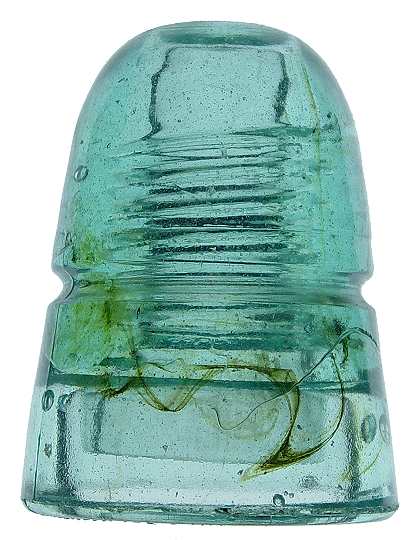
There is also evidence that base embossed insulators bearing the name
National Insulator Company may have had a connection to Samuel Oakman. Business
records, as well as manufacturing styles, indicate a link between Oakman and the
operator of National Insulator Company, Lawrence Gray.
A specialty collection of insulators related to Samuel Oakman would be most
challenging, especially if you included the potential connection of Lawrence
Gray's National Insulator Company, which made CD 110.5 insulators for the New
England Telephone and Telegraph Company. But wait. This is an article about the
American Insulator Company beehives.
The Patents
Up to as many as three patent dates can be found on American Insulator
Company beehives. The one issued on September 13, 1881 was not for an insulator,
but for an insulator's threads. Under this patent, the threads were previously
formed as a glass thimble, and then inserted into the unthreaded cavity of an
insulator in the mold while the glass was still hot. In describing this patent,
an article in "A History and Guide to North American Glass Pin type
Insulators by John & Carol McDougald" reads... "Insulators
manufactured using his September 13, 1881 patent are somewhat crude in general
appearance and usually are not threaded in the upper quarter of the insulator's
pinhole. The threads are rather well-defined in most cases.
"Oakman's September 9, 1884 threading process created finer threads
which seem to gradually fade away as they reach the top of the pinhole. There
are also a pair of vertical lines going up each side of the pinhole with a small
dot on each side of the pinhole's upper section" on the 1884 dated
insulators."
The November 13, 1883 patent date refers to another Oakman invention... the
inner skirt. Many Brookfield beehives manufactured during this era bear the same
patent date. Did Brookfield pay royalties to Oakman?
Embossings
Four different embossing configurations are found on CD 145 beehives made by
the American Insulator Company. They are all based embossed. McDougald's book,
Insulators Price Guide, describes the embossings as follows:
AM. INSOLATOR CO. N.Y. DOUBLE PETTICOAT / PAT'D SEPT. 13, 1881, NOV. 13, 188
,NOV. 188 (Note spelling error, backwards numbers & no date in third
patent.)
AM. INSULATOR CO. N.Y. DOUBLE PETTICOAT / PAT'D SEPT. 13, 1881, NOV. 13,
1883, FEB. 12, 1884 (Note: this style has a letter on the dome.)
AM. INSULATOR CO. N.Y. DOUBLE PETTICOAT / PAT'D SEPT. 13, 1881, NOV. 13,
1883, JAN. 29, 1884 (Note: this style has a letter on the dome; note January
date.) .
AM. INSULATOR CO. N.Y. DOUBLE PETTICOAT / PAT'D SEPT. 13, 1881, NOV. 13, 1883
(Note: this style has a letter on the dome; note there are only two patent
dates.)
The first of the four embossing styles is scarcer to find. Aqua insulators
embossed in that manner are listed as being worth five or six times more than
aqua insulators in the other three embossing variations.
No Inner Skirt Variety
Not all American Insulator Company beehives are CD 145's. There are a few
that lack inner skirts and are listed as CD 143.4's.
Two embossing varieties are noted in McDougald's Price Guide:
AM. INSULATOR CO. N.Y. DOUBLE PETTICOAT / PAT'D SEPT. 13, 1881, NOV. 13, 1883
(Note: this variety has a letter on the dome; note two patent dates.)
AM. INSULATOR CO. N.Y. DOUBLE PETTICOAT / PAT'D SEPT. 13, 1881, NOV. 13, 1883
FEB. 12, 1884 (Note: this variety has a letter on the dome; note three patent
dates.)
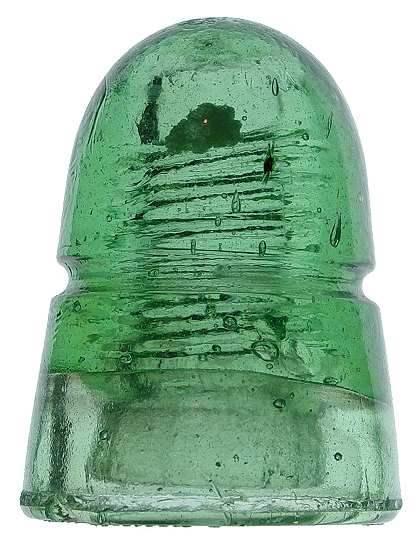
The pictures below show the CD 143.4 beehive. There's definitely no inner
skirt, even though the embossing contains the Nov. 13, 1883 patent for an inner
skirt. The same is true for Brookfield CD 143.4's without an inner skirt;
they also are embossed with the Nov. 13, 1883 patent date. American Insulator
Co. CD 143.4's are only listed in blue. Even though they lack the dramatic
colors of their CD 145 cousins, they are valued in the Price Guide at ten times
the price of blue 145's.
Location
The American Insulator Company was in business for the better part of the
1880's. The volume of insulators produced could have been staggering. Lawrence
Gray, mentioned earlier in this article as a contemporary and potential partner
with Samuel Oakman, operated a glass factory that claimed to be able to produce
15,000 insulators per day. At that rate, a million insulators could be produced
every 67 working days.
Whether millions of American beehives were made or not is not known. But with
potential production volumes of that significance, it's not surprising that
American beehives have literally been found throughout the country. We are aware
of at least one example taken down from service on the Southern Pacific Railroad
Line in Northern California.
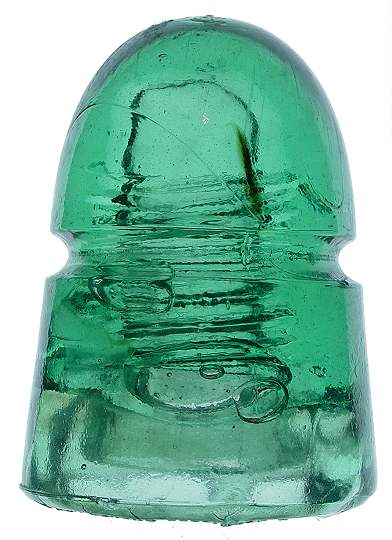
References:
Insulators, A History and Guide to North American Glass Pin type
Insulators,
by John & Carol McDougald, 1990.
Insulators Price Guide, by John & Carol McDougald, 2003.
Brookfield Insulators, by Henry Morgan Brookfield IV, 2000.
Photography by Howard Banks. Photo editing by David Banks.
Thanks to Jack Roach for allowing us to photograph his American beehives.
Thanks to Tommy Bolack for sponsoring the color printing.
We did not attempt to list embossing variations for specific insulators
shown, but focused on colorful examples. The next two pages show some of the
most desirable American beehives known to the hobby.
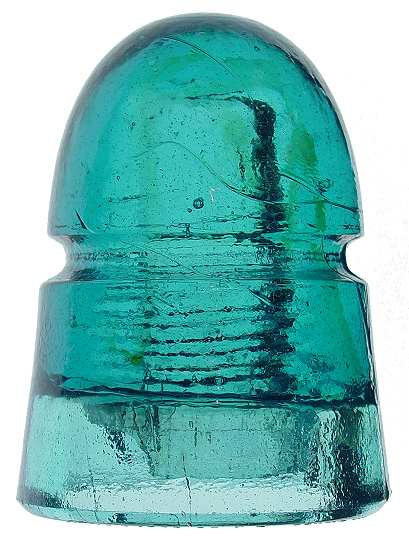
ALL AMERICAN LINEUP
| 